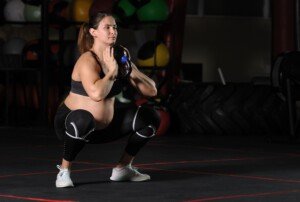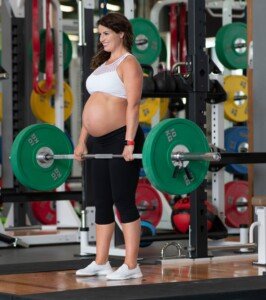An OBGYN was squatting at the gym the day she gave birth to her daughter and explains how to safely perform squats, deadlifts and lunges during pregnancy.
The answer to “Can I do squats, deadlifts and lunges during pregnancy?” is not quite as straightforward as the answer to “Should I avoid smoking during pregnancy?”
“This is a tricky question because there are many factors involved,” begins Mylaine Riobe, MD, founder of Riobe Institute of Integrative Medicine.
Dr. Riobe, who’s board certified in ob/gyn and integrative medicine, is the author of “The Answer to Cancer” and has over 15 years’ experience using integrative techniques to treat diverse patients.
Dr. Riobe continues, “If a woman has already been lifting moderate weights long term prior to her pregnancy, and her pregnancy is uncomplicated in any way, it’s fair to say that she can continue to lift weights under physician supervision.
“Certain precautions must be taken including proper nutrition, hydration and balance. During the first trimester in such a case, there are minimal restrictions.
“At the outset of the second trimester, it’s important to avoid lying flat on the back; this can cause the uterus to block the major veins (the vena cava) and cause poor blood flow.”
So while the squat, deadlift and lunge are definitely in, during the second trimester, the bench press is definitely out!
“It’s important to be standing or inclined, and not flat,” says Dr. Riobe.
“I’m an avid weightlifter and I exercised throughout my pregnancy and was squatting at the gym the day I had my daughter, so it’s very doable, with proper caution.
“If the pregnancy is complicated in any way, it’s imperative to discuss exercise with your physician to see what specific restrictions would apply.”
Detailed Guidelines for the Squat, Deadlift and Lunges While Pregnant: Do Them Safely
As Dr. Riobe explained, if your body was trained in the squat, deadlift and lunges prior to becoming pregnant, and your body is thus used to the demands of this kind of training, then it’s a go – within the context of letting how you feel during the workout dictate whether or not it’s time to take a break or cease for the day.
Even a very trained woman who warms up with a 135 pound squat can suddenly become nauseous; you’d better rack the bar and have a seat, and perhaps call it a gym day.
No matter how trained you are, plenty of hydration and nourishment is crucial. Munch on grapes or a banana between sets, for instance.
For trained as well as novice women, the factor of balance equally applies. Just be careful you’re not moving through the gym in a way that can cause a fall.
Gee, eagerly trotting up the staircase to the free weight area could result in a stumble and hard fall to the steps.
- Watch where you’re walking on the gym floor. Tripping hazards are always present.
- Be careful in the locker room where puddles of water on the floor can cause a slip-and-fall.
An expectant woman is actually more likely to sustain damage to her body simply falling or losing her balance doing some nutty one-legged routine than from keeping both feet on the floor during a barbell or kettlebell squat.

Shutterstock/Serghei Starus
What about exertion?
Go for it, as long as #1) You feel good, and #2) You’re not putting yourself at risk for losing balance such as attempting squats while standing on a BOSU board.
Your primitive ancestors, when pregnant, didn’t have the luxury of driving or Uber to get around.
They had to walk long distances on rough terrain and carry buckets of water, firewood or whatever, sometimes with a toddler strapped to their back!
The human body—including female—was designed for physical exertion. The old school of thought was for pregnant healthy women to “take it easy.”
The new school of thought among ob/gyns is that structured exercise helps lower the risk of pregnancy related complications, gestational diabetes, delivery problems and low birth weight.
Exercise during pregnancy will also help with food cravings and mood swings.
Untrained Women Who Want to Get in Shape While Pregnant
There is nothing inherent in the motions of the squat, deadlift and lunge that increase the risk of miscarriage or other pregnancy related complications.

Shutterstock/Paul Aiken
These multi-joint motions are simple, steady and non-erratic. There is no jumping, impact or sudden changes of direction.
And don’t forget that with the squat, deadlift and stationary lunge, you’re standing in one spot the entire time with both feet on the floor at all times. How safe is THAT?
Basic Safety Guidelines
• Always warm up by doing the exercises you intend to train at.
• Hydrate prior to workout.
• Have quick-acting carbs readily available.
• Before you progress in amount of resistance, make sure you have nailed excellent form.
• Don’t try to set records.
• Never hold your breath during a lift. Exhale on the exertion and inhale on the release.
• Stop if you feel ill or not right.
Deadlift During Pregnancy Safely

Shutterstock/Paul Aiken
• What’s “heavy” is relative. Do five to 10 reps of whatever weight challenges you.
• After the last rep, lower the bar carefully.
• Be a stickler for perfect form!
Squat During Pregnancy Safely
• If the back squat is uncomfortable, try other versions such as holding dumbbells at your shoulders or with straight arms; the Smith machine or the plie squat (shown below).

Plie squat. Freepik.com
• Be a stickler for perfect form!
Lunge During Pregnancy Safely
• This can be done stationary or walking-style.
• Hold dumbbells with straight arms or press them over your head.
• Do not round your back or lurch forward. If you must lean forward, the weight is too heavy.
• You can also hold a weight plate or heavy ball at your chest.
Never let other issues stop you from strength training while expectant. These include feeling “too fat,” “too bloated” or believing you’ll endanger your baby’s health.
If you hydrate and nourish, follow general exercise guidelines for pregnant women, use good form and avoid balance moves — the squat, deadlift and lunge will be among the best things you can do for your baby.

Dr. Riobe has helped thousands of patients overcome difficult illnesses by addressing root causes, not just masking symptoms. The Riobe Method focuses on the prevention of disease, not the prevention of death from disease. She has 20+ years’ experience using integrative techniques to treat diverse patients.
 Lorra Garrick is a former personal trainer certified by the American Council on Exercise. At Bally Total Fitness she trained clients of all ages for fat loss, muscle building, fitness and improved health.
Lorra Garrick is a former personal trainer certified by the American Council on Exercise. At Bally Total Fitness she trained clients of all ages for fat loss, muscle building, fitness and improved health.
.








































